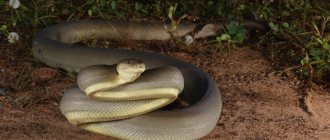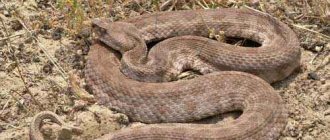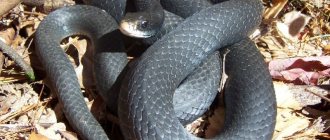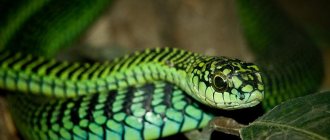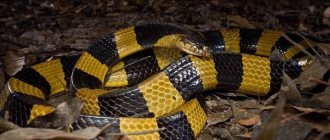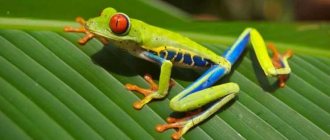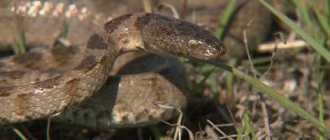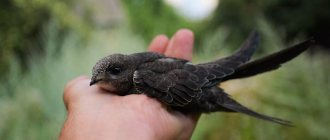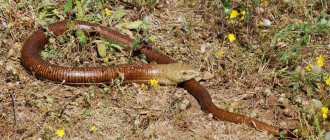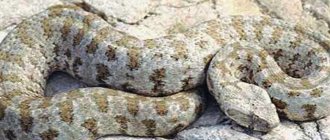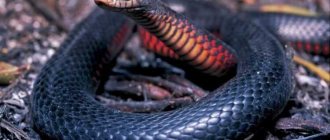There are more than 3.5 thousand species of snakes around the world, a quarter of them are poisonous.
Snakes are found on land, but there are species that exist underground, in water and in trees. The main habitat of reptiles is in areas with warm climatic conditions. You can meet snakes in the steppes, deserts, mountains, and forests.
Snakes live on almost all continents of the planet, with the exception of cold Antarctica. Many reptiles are found in India and Burma.
There are about eleven species of venomous snakes crawling in Russia, which are more common in Siberia, the Far East and the Caucasus.
African Pygmy Viper / Bitis peringueyi
In the vastness of Africa, there lives a poisonous dwarf viper, the size of which does not exceed 20–25 cm. But individuals with a length of 32 cm have been caught.
It is distinguished by its wide flat head and characteristic coloring. It camouflages perfectly with the color of the sands in which it lives. On hot days it hides in the shade of bushes, burying itself in the sand. Only the nostrils and eyes and the tip of the tail remain on the surface.
Buries itself in the sand using vibrating movements. This viper also has a peculiar lateral movement. Where it crawls, bizarre patterns remain on the sand. Hunts lizards. When captured, it releases a huge amount of poison, which instantly kills the victim. The poison is not fatal to humans.
2
Spitting mechanism
Spitting cobras, photos of which can be seen in our material, shoot venom through curved channels that are located in the teeth. Such holes can open at the first need. The toxic substance is produced from the channels due to the contraction of special muscles on the snake's neck. This is where the glands are located that replenish the supply of toxic substances.
After leaving the cobra's mouth, toxic substances can reach a target at a distance of up to three meters. As the results of special studies show, such snakes have the ability to accumulate venom, the volume of which is sufficient for several dozen “shots” at a time.
The described mechanism is observed in African spitting cobras. The Central Asian variety is also capable of shooting poison over a considerable distance. However, in this species, the toxic substance shoots out from a special hole under the tongue, in the area of the lower jaw.
The main purpose of the defense mechanism is to get toxic substances into the eyes of the enemy, be it an animal or a person. Having detected danger, the cobra raises its head and keeps the target in sight. Then a spit occurs, which is directed slightly above the enemy’s head. Having reached its destination, the poison leads to clouding of the cornea of the eye in a short time. The result is often complete blindness of the victim. Moreover, toxic substances irritate the skin, causing destruction of its structure.
Sometimes spitting cobras make mistakes. But this doesn't happen often. The reason is usually a good reaction from the potential target. In some cases, cobras mistake shiny elements on a person’s clothing for eyes.
Mulga
The venomous snake is also called the brown king because of its color. Mulga lives in forests, deserts and fields. It is impossible to meet her in the jungle. Australia is the main home for this species of snake.
The size of the reptile is quite impressive; its length can reach up to three meters and its weight up to seven kilograms. The brown king has a peculiarity: its head is smoothly connected to its neck, which hides its salivary gland with poison. When a snake is ready to attack a victim, the muscles on its neck increase, but a hood does not appear, like a cobra’s.
Mulga uses various amphibians, insects, small birds and even snakes, sometimes poisonous, for food.
Rattlesnake
Rattlers are found in North, Central and South America. All of them are poisonous, and the bite of some rattlesnakes can cause death. They got their interesting name due to the presence of a rattle - a thickening in the tail part. When danger approaches, the tail begins to vibrate and make a cracking noise. All nearby animals immediately guess what this crackling noise means.
The venom of this snake has hemotoxic properties: it causes coagulopathy (blood stops clotting) and also causes the death of organs and tissues. Its effect makes a person’s neck muscles hard as stone. The most toxic rattlesnake found in North America is the diamondback rattlesnake. One bite from this reptile would be enough to kill 15,000 mice. Its poison can cause not only hemorrhage, but also paralysis of the muscles of the respiratory system.
There is a chance to reduce the probability of death to 4%: the victim must be provided with timely medical assistance. But the scar from the bite will still remain.
Nosed enhydrina
This inhabitant of the Indo-Pacific waters is the leader in the number of fatal bites among all sea snakes. Residents of the Indian coast have every chance of encountering the big-nosed enhydrina, since the snake is active at any time of the day. Among the local population there are many connoisseurs of its meat, and ironically, the victims of this snake are often those who hunt it themselves. This storm of the seas treats troublemakers, that is, all people who find themselves next to her, extremely aggressively. When bitten, it immediately releases 5 lethal doses of poison. Without an antidote, a person simply has no hope of salvation.
Central Asian cobra
Scientific name: Naja oxiana LD 50 Value: 0.21 mg/kg - 0.4 mg/kg.
The Caspian cobra or Central Asian cobra is perhaps the most poisonous species of cobra in the world. Its venom is more powerful than that of the Philippine cobra. The average specimen of the species reaches 1 meter in length, although the longest can be over 1.5 meters. As the name suggests, it is indigenous to Central Asia.
Although the Central Asian cobra is primarily diurnal, it can become nocturnal (active at night) and even crepuscular during the hottest period of the year. They are fast, agile and can also be found on the water.
Serious health problems such as ataxia and paralysis occur within an hour of a snake bite. Nucleases present in the venom of the Central Asian cobra cause local tissue damage. It also accelerates and enhances the effects of neurotoxins.
Malayan blue krait
This snake is found in Indonesia and Southeast Asia. The Malayan krait is a nocturnal predator. Loves to hunt other snakes. Having made a bite, the krait does not let go of the victim, but presses its jaws several times so that the poison penetrates as deeply as possible.
This poison is a powerful neurotoxin. It is much stronger than that of a cobra. 16 times! Its action causes paralysis very quickly. Half a day is enough for death to occur.
Sandy efa
In Asian countries (on the Arabian Peninsula, India, Sri Lanka and South-West Asia) and Africa, ephas are found in sandy deserts and dry savannas. They become especially active after rain. These snakes have decent speed and a special way of moving along sand dunes. The sand epha has a somewhat unusual venom that acts very slowly: from the moment of the bite it can take 2-4 weeks before the person dies. The bite site begins to hurt first, then the bitten limb swells, blood pressure drops and tissue necrosis begins. But with timely administration of serum, a fatal outcome can be avoided. Sandy Effs have a rather aggressive and irritable character. Moreover, their habitat often comes into contact with the environment of human activity. Ephs are active at night. They attack with lightning speed, injecting hemotoxin, which destroys red blood cells, as well as muscle and organ tissue. In general, mortality from ephas bites is at a very high level.
Top articles : Temperate forests (temperate forests)
Patient predator: Schlegel's prehensile-tailed bothrops
In the world of snakes there lives a snake that is not like any of these representatives. If you look at a photo of Schlegel's prehensile-tailed bothrops, then at first glance the snake may seem harmless. The snake camouflages itself masterfully. The dazzling color helps it blend in with fruits and flowers. However, after meeting her, the man is not laughing. This snake's attacks are deadly. Its venom contains hemotoxins, which in a matter of time dissolve the blood and tissue around the bite site. In the deep structures of the human body, myo toxins at this time destroy muscle cells, stop the heart or paralyze the contraction of the diaphragm, which inevitably leads to respiratory arrest.
Striated Wolftooth / Lycodon striatus
The small striped snake lives in Nepal and India, and adult individuals do not grow more than 45 cm. It belongs to the colubrid family.
They got their unusual name from their characteristic long fangs. When they bite, they leave sharp wounds on the victim's body. They are not poisonous and do not pose a danger to humans. But after a bite, the wound should be treated to prevent infection.
The wolftooth has an unusual color. The dark body has transverse light stripes. The closest related species lives in Thailand, and is not much larger in size. The Thai wolftooth reaches a length of 50 cm.
6
African boomslang
To kill a person, only 12 mg of his poison is enough. This is the only poisonous representative of the Colubridae family. The reptile lives in Sub-Saharan Africa. The green color makes the snake difficult to see on the tree. The teeth of the boomsalang are located in the middle of the mouth, due to which the poison is carried into the body of the victim when the prey is tightly captured in the mouth. The main components of the poison are neurotoxin and hemotoxin, which leads to the rapid destruction of erythrocytes (red blood cells). The snake is afraid of humans and tries to avoid meeting them. She can only bite if you grab her. Carl Paterson Schmidt, who was a zoologist and herpetologist, died from a boomslang bite in 1957.
Viper
The viper family represents more than 200 species. They are distributed all over the world, including in Russia. To survive the cold and lack of food, vipers hibernate during the winter. They overwinter in underground burrows, sometimes gathering into balls of several dozen individuals.
The sand epha is considered the most poisonous of the vipers. She lives in India and China. Its peculiarity is the ability to become more active after rain. It stalks its prey by burying itself in sand or fallen leaves.
Vipers have such long poisonous teeth that, when closing their mouths, they are forced to bend their points back. These teeth at the base are equipped with special joints that act like hinges.
The heart of the bitten victim begins to beat more slowly, and the pressure gradually drops. The affected area swells, begins to hurt, and bleeding is possible. The victim experiences pain throughout the body, this pain can be felt for up to 2 months. A sad outcome may be death from respiratory arrest after 1-2 weeks.
Main differences
There are a number of signs by which you can distinguish a poisonous snake from a non-dangerous one:
in dangerous reptiles the head resembles a triangle and is clearly separated from the neck by an isthmus; in non-poisonous reptiles it is round or oval in shape and smoothly passes into the body; non-dangerous snakes have a round pupil, while in poisonous ones it resembles a vertical ellipse and looks like a cat’s; poisonous reptiles, as a rule, are brightly colored in contrast to non-dangerous ones; If a poisonous reptile opens its mouth, you will notice two fangs. Non-dangerous ones do not have these; in dangerous snakes, you can see heat-sensitive pits between the nostrils
Non-venomous snakes do not have them; The main characteristic of venomous rattlesnakes is the rattle tail; Non-dangerous reptiles have two rows of scales on their tail, while dangerous ones have one; if you see a snake swimming, you should know that only a poisonous one swims with its body on the surface of the water; If you can safely examine the snake, pay attention to the part of the tail behind the anus. In poisonous ones, it is the same as the whole body, while in non-toxic ones, a transverse pattern in the form of diamonds is visible; at the site of the bite of a poisonous reptile there will be points from two fangs, and only a scratch from a harmless one.
However, many rules have exceptions. In the case of snakes, there are the following:
- The coral adder has a round head, but is deadly. And some endangered, non-venomous reptiles flatten their heads into a triangular shape;
- There are a sufficient number of reptiles with bright colors, but they are not dangerous. And vice versa, in the middle and southern latitudes, poisonous snakes are inconspicuous and inconspicuous, their color blends with their habitat;
- such deadly snakes as mamba, taipan, and asp have round pupils, although they should resemble vertical slits.
Did you know? Some snakes may have three hundred pairs of ribs.
South China multi-banded krait (lat. Bungarus multicinctus)
Habitat: swamps, plantations, mangrove forests and shrubs of Burma, Laos, Taiwan, Vietnam, as well as mainland China.
Length: 1.5 – 1.8 m.
Color: black with white transverse stripes.
LD50 indicator: 0.108 mg/kg.
A snake with a bright color and a fatal bite, from which every second victim dies, regardless of the provision of assistance and the administration of an antidote. According to statistics, from 50 to 85% of attacks are fatal. Just one bite of it would be enough for ten. The toxin causes convulsions, difficulty breathing, blurred vision, diplopia, loss of voice, chest discomfort and general pain, leading to paralysis. After 6-12 hours, death occurs.
The behavior of kraits depends on the time of day. During the day they are lazy and slow, and at night they attack without warning. These adders have a habit of settling near residential buildings, fields and vegetable gardens, which also makes unpleasant encounters with people more frequent. The krait attacks like a viper, throwing out its head and sinking its teeth, which, by the way, are quite capable of biting through good-quality shoes.
Black Mamba
Black mambas are distinguished by their speed, aggression and extreme venomousness. Numerous human casualties are associated with them, and African legends extol the capabilities of the mamba to colossal proportions. That is why the black mamba is often called the most poisonous snake in the world.
To dispel the myths, we present to your attention 10 interesting facts about the black mamba:
- Black mambas are not actually black. They are gray, brown, or olive in color with a lighter belly. They get their name from their blue-black colored mouth. The snake shows its rage with its mouth open in a rather frightening way.
- What really makes this snake deadly is its impressive speed. This is the fastest of all land snakes studied, capable of reaching speeds of up to 20 km/h.
- Black mambas are also the longest and second most venomous snakes in Africa. The average length of a mamba is 2.5 meters, but the longest snake recorded in 2022 reached a length of 4.2 meters.
- Black mambas are native to the rocky terrain of Southeast Africa, but also live in savannahs.
- The deadly danger of these snakes lies not only in the amount of poison. When threatened, they become aggressive, delivering numerous bites and injecting large volumes of venom.
- There are myths that there is no antidote for a black mamba bite. In fact, it exists, but for most of those bitten it is inaccessible. For this reason, the snake is responsible for more than 20,000 deaths annually.
- The lifespan of a black mamba in the wild reaches an average of 11 years.
- A super fast snake can easily outrun a human. But African myths say that a mamba can outrun even a horse. This is definitely a myth.
- Another superpower of the black mamba is its ability to hold 1/3 of its body in the air. From the outside it looks like a poisonous snake is rising above the ground.
- The black mamba's neck valve is similar to a cobra's and opens when in danger.
Best articles: What straits and bays wash Australia and New Zealand - list, description and map
Parademancia
0
These snakes have the most toxic venom of any land species. The amount of venom in one bite can reach 110 mg, which is enough to kill 100 people. Fortunately, these snakes are not aggressive and very rarely attack humans. There are no known deaths, although this snake can cause the death of an adult within 45 minutes with its bite.
Which snakes are not poisonous
There are many more non-venomous reptiles than dangerous ones. Let's get to know them better so as not to cause harm:
The common snake is distributed throughout almost all of Europe and is found in some parts of Asia.
Also check out such non-venomous snakes as: tiger python, milk snake, reticulated python, corn snake, yellow-bellied snake and aesculapian snake.
In our middle latitudes the common copperhead is very common. Its length, as a rule, does not exceed seventy centimeters, and a fourth or fifth of the body is on the tail. The color of its back and belly is red-brown, copper. Hence the name of the reptile. Black spots are noticeable on the body; an arc of the same color runs from the nostrils to the beginning of the mouth. There is often a dark arc-shaped stripe on the head.
The snake also lives in our latitudes. It is less common and is represented by many species, and, accordingly, colors. Its distinctive feature is that it is very similar to a boa constrictor. And in length more than two, or even three meters.
Important! Non-venomous snakes should not be killed, especially snakes. With their smell and actions, they, in particular, repel vipers
If the snakes leave, vipers can easily take their place.
Dubois sea snake (lat. Aipysurus duboisii)
Habitat: corals of the coastal zones of the South China Sea, the coast of Australia and the Malay Archipelago.
Length: 0.8 – 1.10 m.
Color: pale brown with dark brown spots on the sides and back.
LD50 indicator: 0.043 mg/kg.
Although Dubois lives in shallow water, the snake periodically comes to the surface to breathe oxygen. At such moments, bathing people can become victims of the sea serpent. Although Dubois is not aggressive, due to its color, vacationers can accidentally step on the snake, which is almost invisible in the water, thereby provoking a conflict. Toxins injected into the victim suppress the impulses of the nervous system responsible for breathing, cause paralysis of the lungs, and the victim simply dies from suffocation. Aipysurus duboisii is rightfully considered the most poisonous of sea snakes, because according to statistics, about 150 people die from its bites per year.
The positive point is that, despite the high toxicity of the poison, it is administered in small doses, and therefore death is possible only if the snake shows strong aggression and inflicts multiple bites. In addition, DuBois uses venom in only 10% of bites.
Australian spinytail
The spiketail has a triangle-shaped head. It is not very long and graceful. This reminds me of a rattlesnake. But the properties of the toxic substance in its glands affect living organisms differently.
This representative of reptiles does not hesitate to feast on its relatives. Attacks snakes from a secret place. Death from an attack by the Australian spinytail occurs as a result of paralyzed respiratory arrest. Its venom is neurotoxic. Death can occur within six hours if antivenom is not administered. The antidote relieves the main symptoms and alleviates the condition of the victim. The chance of survival without the use of medication is no more than 50%.
Harlequin coral adder
These colorful beauties live in some parts of North America. They spend most of their lives in shelters underground or buried in fallen leaves. They are chosen into the world mainly for procreation. Their main diet is small lizards and snakes, as it is difficult for them to bite through the skin of something larger. Knowing its weaknesses, the coral adder will not attack people. But contact with this snake can happen accidentally, for example, if a person steps on it in the garden. The venom of the harlequin adder often leads to death, although it does not act as quickly as that of some other snakes. There is approximately 20 to 24 hours to administer the antivenom.
What is the most poisonous snake in the world?
TOP 10 most poisonous snakes on the planet. The rating goes from less poisonous to more poisonous.
Deadly viper
In most cases, the poison will not cause danger, because very weak, but there have been cases when people died after a while. Therefore, if a bite occurs, you need to seek help, even if the location of the bite does not bother you.
African boomslang
The poison is several times stronger than the venom of a viper and when it enters the bloodstream, it almost immediately destroys the cells of the body. Scientists conducted an experiment on ducks. After being bitten by this snake, they experienced paralysis within 1-2 minutes, and after 15 minutes they died. Most often they can be found in Africa, on branches and in bushes.
Oriental or harlequin asp
Dangerous to human life. If medical assistance is not provided within 24 hours after the bite, the likelihood of death is very high. Length from 90 to 100 cm, they can most often be found in the southern United States, feeding on insects and lizards.
Sandy efa
The next snake belongs to the viper family and is called Sandy Efa. It feeds on small rodents, sometimes birds, and most often lizards and scorpions. The average length is from 55 to 60 cm, in some cases reaching 75 cm.
Hook-nosed sea snake
The snakes listed above are found on land, but this one can be found in the water. It is considered not aggressive, but even so its venom is 5-6 times stronger than the venom of a cobra. Capable of diving to a depth of one hundred meters and staying there without air for about five hours. You can meet her off the coast of India, the Arabian Sea and also on the islands of Madagascar.
Brown king or mulga
The venom is less toxic than that of previous snakes, but a larger amount of venom is injected when biting. It is less aggressive, in 80 percent of cases it stalks its prey in ambush.
Malay krait
A very aggressive and poisonous snake; when bitten, 50 percent of people die, even if a special vaccine is used. You can find them in small burrows, bushes, and also in private houses, where they very often crawl. Habitat: South Asia and Australia.
Taipana - Oxyuranus scutellatus
One of the three most poisonous snakes on the planet. Its length ranges from three to 3.5 meters, and its large teeth, 1 cm long, inject such an amount of poison that the victim dies within a few minutes. Most often found in Australia.
Brutal Taipan
It ranks second in the ranking of the most poisonous snakes. The main food is small mammals. Also found in Australia, it is most often found in fields and dry plains. One bite can kill about a hundred people or a quarter of a million mice.
The tiger snake is the most poisonous snake in the world
She received this name because of her tiger coloring.
After the poison enters the blood, literally within a few seconds it paralyzes all nerve endings and the victim dies due to cardiac arrest.
Best articles: Which natural resources are inexhaustible?
It lives in Australia and mainly feeds on birds, frogs and mice.
One female can give birth to at least 50 baby snakes.
Up to two meters long.
The chance of a person surviving a bite is very small, but in any case it is necessary to seek help as soon as possible, or try to suck out the poison from the bite site yourself.
Labaria or kaisaka
Only 50 mg of its poison is enough to cause death. This representative of pit snakes from the viper family lives in the tropics of South America and some regions of Central America. This aggressive snake is not afraid of people and often crawls into their homes. Its yellow-brown color is quite invisible. The snake's venom acts rapidly, and death occurs within a few minutes after the bite. Most often, the victims of this reptile are workers of coffee and banana plantations.
The most dangerous poisonous snakes
Snakes are known to use venom to forage for food and protect themselves. Before attacking the victim, they warn her. These predatory creatures swallow the caught trophy whole, without chewing, and in order for the prey not to interfere with this process, the snakes bite and release poison into them.
An interesting fact is that during self-defense, reptiles secrete more poison than during hunting.
Which snakes are the most poisonous and dangerous? First of all, these are the Rattlesnake, Mulga, King Cobra and Taipan.
When a person is bitten by any of these snakes, his rapid death is inevitable. Only an antidote will help. A small percentage of such cases have been identified in the world, but let’s still take a closer look at each type of these predatory creatures.
Taipan
The taipan is the most poisonous reptile snake in the world. This reptile's venom is very toxic, unlike cobras. The poison can poison up to a hundred people at a time.
These snakes are widespread in Australia. Their main habitat is dense forest, as they love to crawl through trees. Less common are fields and meadows located far from bodies of water, because reptiles do not tolerate moisture.
Taipans stay awake during the daytime, and if the heat sets in, they go into the shade, waiting for the evening time to hunt.
Snakes spend half their lives hiding behind trees to catch prey, despite this, they have a fairly fast movement reaction. When an individual begins to eat food, its mouth opens very wide so that the food can pass through without any obstruction.
Red spitting cobra - Website mortal-sting!
Red spitting cobra (Naja pallida)
These deadly creatures are found in Asia, but are mainly found in Africa—species of cobras such as the black-necked spitting cobra and the great brown cobra have long instilled mystical horror in local residents. The large brown spitting cobra can reach 2.74 m in length, and one portion of its venom is enough to kill 20 people. Spitting cobras got their name due to their ability to shoot poison into the eyes of the enemy at a distance of up to three meters with incredible accuracy. Scientist Bruce Young of the University of Massachusetts took incredible risks precisely to determine why spitting cobras are so effective at striking the eyes of their prey (by the way, the term “spitting cobra” is a misnomer, since the snake actually does not spit out poison - the release of a “deadly cocktail” from the fangs in the form of thin jets is caused by sudden muscle contractions). Brave Bruce Young teased the snakes by moving his head in front of the dangerous reptile. On Young’s head there was a special device connected to a computer that allowed him to monitor the head movements of both the experimenter and the snake. His eyes were protected with special glasses. His colleagues filmed the entire experiment with a special high-speed video camera from the side. The cobras “spit” into Bruce Young’s eyes more than 100 times before the footage made it possible to understand the secret of the snakes’ amazing accuracy. It turned out that the cobra anticipates the movements of the head and, accordingly, the eye of the victim - it spits “in anticipation” 200 milliseconds - at a certain point where the victim’s eyes will be after this insignificant period of time. In addition, for greater effect, a second before releasing the poison, the snake began to rotate its head using the muscles of the head and neck and continued to move, releasing the liquid. Accordingly, the poison is sprayed in the form of intersecting ellipses, most likely hitting the enemy’s face, and in both eyes at once. The experiment also showed that the cobra does not release its venom as a stream, but rather as an aerosol.
A scientist from the University of Massachusetts voluntarily became the target of a spitting cobra, a dangerous creature capable of blinding and even killing its victim without biting it. However, the risk was not in vain. Thanks to this study, it was possible to establish that the incredible accuracy of the deadly spit is ensured by the amazing reaction of the terrible snake, which, carefully observing the victim's eyes, anticipates a change in the position of the face 200 milliseconds before the movement itself.
Biologists from the University of Massachusetts were able to establish how spitting cobras maximize the chances of getting “spit” into the eyes of the victim: it turned out that instead of precisely aiming, the snakes prefer to spray it in a special way in the direction of the victim. The researchers' work was published in the journal Physiological and Biochemical Zoology, and a summary is available in a press release from the University of Chicago Press, which publishes this journal. Previously, scientists assumed that snakes have a special aiming mechanism that allows them to achieve amazing accuracy: almost 100 percent hit from a distance of 60 centimeters. New results show that this is not the case.
As part of the study, scientists studied the “spitting” mechanism of cobras using high-speed photography, as well as electromyography data from the snake’s muscles. As a result, they found that during the release of venom, the snake turns its head, introducing vibrations into the relatively smooth flow of its stream. These fluctuations are of such a nature that, on the one hand, they increase the chances of hitting, and on the other hand, they do not allow the poison to splash onto large area and retain the danger of “spitting”. The term "spitting cobra" is a misnomer because the snake does not actually spit out venom. Instead, sudden muscle contractions cause the liquid substance to be released from the fangs in thin streams. In order for the attack to be successful, it is necessary that the poison gets into the victim’s eyes - this leads to severe pain or even blindness.
Ephas, or sandy ephas (lat. Echis carinatus)
In addition to being one of the Big Four, sand ephs are ranked third in the Top 10 Most Dangerous Snakes due to their irritable, aggressive nature and deadly venom. And also their habitat is in close proximity to people. They are nocturnal and can be seen in the late evening in arid areas and dry savannas north of the equator, including Africa, Arabia, Southwest Asia and India, as well as Sri Lanka. They strike very quickly, releasing hemotoxin, a poison that destroys red blood cells and causes damage to tissues and organs. Mortality rates from these bites are extremely high. Although the antidote is quite effective along with medical treatment, sand ephs are believed to be responsible for a large number of human deaths.
Tiger snake: terrible secrets
Crawling through the rice fields of Asia and catching frogs, the small, 60-centimeter tiger snake no longer seems dangerous. It is very difficult for him to sink his small teeth into his prey, but if the tiger already grabs its victim, then the second one cannot avoid death. A specific feature of this snake is the release of frog poison, which remains in the glands on its neck. If a predatory mammal approaches a tiger, the snake exposes its glands as a target, and instead of a tasty dinner, the predator gets a mouthful of poison. In this way, the tiger snake preserves its life.
